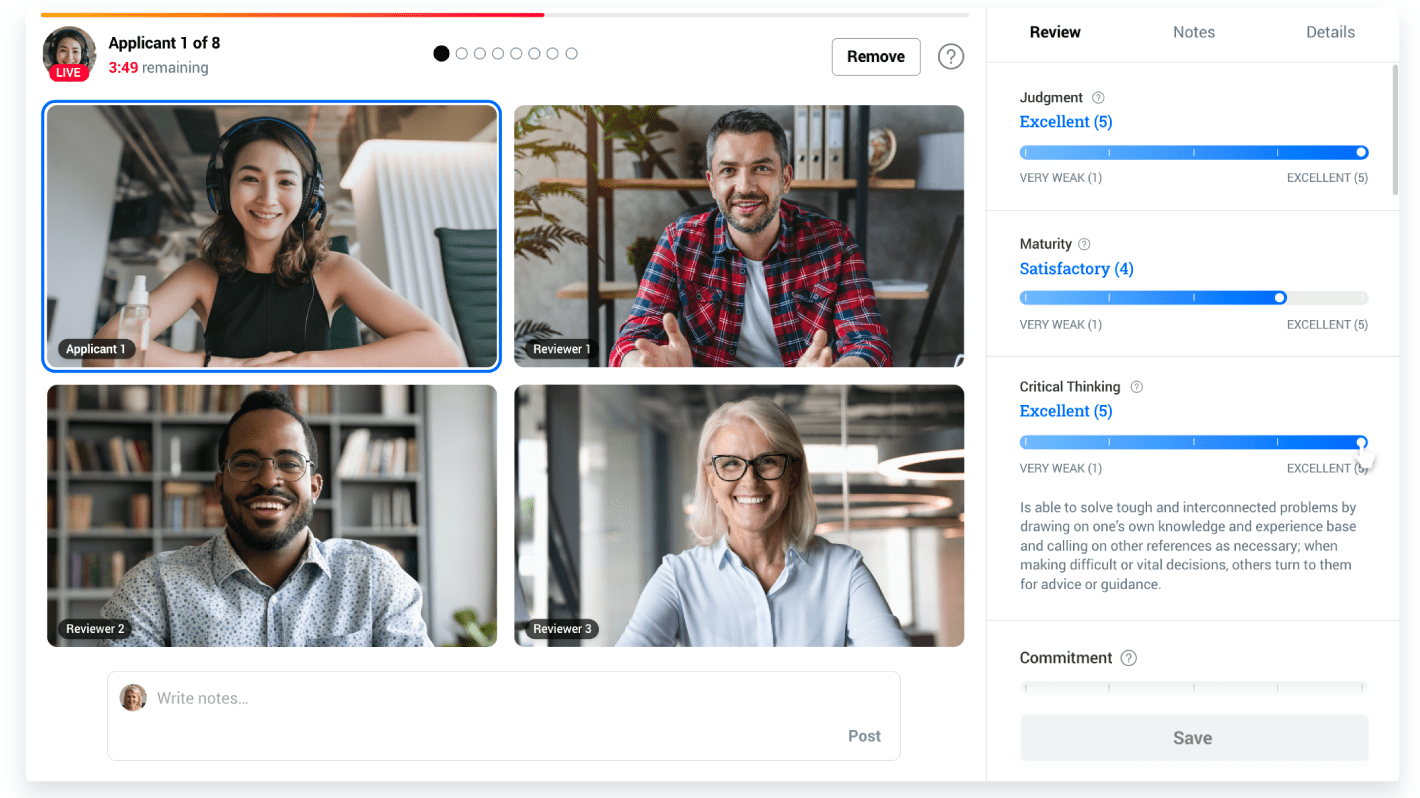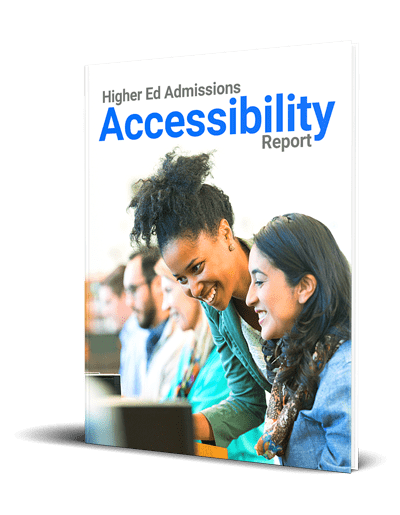Working in institutions that have existed for several decades, maybe even centuries, brings rich traditions, a storied history, and many tangible and intangible barriers for applicants and students.
Rather than a proactive design requirement, many post-secondary institutions are finding themselves struggling to keep up with the legal requirements and best practice guidelines of their physical and digital spaces.
Like adding on a retrofitted-entrance to the back door of a lecture hall, improving the accessibility of our digital tools is, unfortunately, often an afterthought only flagged out of necessity.
Especially now, as schools are transitioning to more online recruitment and classroom learning models for the fall, previously unrealized accessibility issues are popping up.
Inclusive Media and Design (IMD) Founder and Director, Rob Harvie, knows the struggle higher education institutions face all too well.
Harvie and his team at IMD work with dozens of schools in higher education to elevate their web and video accessibility to meet best practice standards.
At Kira Talent, we’ve been fortunate to be a client of IMD as well. They helped us make critical improvements on our platform that ensure we continually offer applicants a fully-accessible experience and meet WCAG 2.0 AA standards.
We connected with Harvie to learn more about what recruitment and admissions teams can be doing to make their admissions process accessible for all applicants.
KT: Working with higher education institutions, what are the “most often missed” web accessibility standards you see when auditing college and university websites? And what is the impact of those oversights for applicants?
RH: Depending on how accessible-web savvy internal designers (or outsourced developers) may actually be, an institution’s online public and student-facing content may very well be laden with violations of the World Wide Web Consortium’s (W3C) Web Content Accessibility Guidelines (WCAG) – a common standard which aims to provide access for all, regardless of user condition or choice of usable interface.
A simple line of code may be keeping people who can’t use a visual display, mouse, or trackpad from entering the resource’s front door, as it were.
The potential issues are just too broad to cover here, though one basic criteria from the standard so often missed is provisioning of video captions. Video is ubiquitous to curriculum now, and not only do captions aid comprehension to those who can’t hear the content, but also for those for whom English is not their first (or second) language.
Accurate captions have been shown to boost intake and comprehension for all. Accurate captions can be leveraged in loud (e.g. on public transit) or quiet (e.g. in the library and forgot your earbuds or headphones?) environments.
Plus, everyone can benefit from glimpsing at that 16-syllable polymer chain, or the surname of a long-gone German philosopher, spelled correctly as it’s spoken.
Accuracy is to be re-emphasized. Lawsuits are being lost by academic institutions around their lack of provision of accurate captions – as opposed to the purely automated sort; and our students deserve better than “autocraptions".
KT: What improvements do applicants want most from the institutions they’re considering?
RH: For new students shopping for an institution, lack of digital inclusion on the public side – wherever they are searching online for more info – or in registering, will be indicative of intuition-wide measures.
Any lack of inclusive digital considerations in the application process (be it forms not properly “marked up” or remediated, or in any online interaction) may not only be a big turn off, but also illegal.
Can your institution afford the negative public image of being exclusionary if named in a lawsuit? (Not that we want that to be a sole motivating factor!)
Your school may be of such a privileged stature that only “the best” applicants make it through the gauntlet. Some of the greatest (and neuro-diverse) minds didn’t fit with what was or is currently considered “elite”.
Are you unintentionally discouraging diverse minds (and the bodies bearing them) from even applying?
Students (and parents) are shopping for not just name and place, but best experience.
Strongly consider how you could legitimately assure stage one clients that your school will support inclusion throughout their education, and not just walk the marketing talk.
Perhaps, worse yet, is to go along with any unspoken claim that people who are disabled just aren’t smart enough to make it into your esteemed establishment. Are you playing a part in being an attitudinal barrier to fostering growth of some great mind and hearts?
Many disabilities are invisible, and whether or not that’s a condition for interviewees, they experience a layer of stress that may border on being incapacitating.
Most of us have experienced that, when our outward appearance and behavior had not been truly representative of our true capabilities. Provide a recourse to forcing the individual to fit the system so that they can truly shine for who they are.
A pseudo-automated registration service may save you time in processing numerous applicants, but you are also filtering out those great minds and hearts if you are disallowing the opportunity to connect to a human and truly be heard.
Make this alternate pathway clearly known as an option.
KT: The admissions interview can be a major source of anxiety. Do you have any recommendations for admissions professionals who are looking to make in-person or virtual interviews more comfortable for applicants with disabilities?
RH: Familiarity with types of challenges and disabilities will help you better understand how you can facilitate communication and assessment. Note: Resources provided at the end may come in handy.
Granted you’ve not enough time in a day to get things done, but try conveying that you are not just a gear in an inflexible institution – in a way you see fit – and then literally ask, “How can I help you?”
This may help you glean their perspective and aid reaching the common goal in front of both you and the applicant in an equitable manner.
This is not so much about giving students a “special consideration” or a free pass due to hardship, but helping put the applicant on an equal footing with their peers, given their context.
Read more: How to consider context and intersectionality in the admissions process
Q: We know it’s so important that accessibility and inclusion work does not happen in a silo. What changes can admission teams make to ensure their institution is prepared, not just to accommodate a student’s needs, but to enable that student to thrive?
It would be a tall order to try and take on ensuring that any specific student’s needs are met outside of your department. You can’t quite drink the ocean. Start with practicing inclusion yourself and ensuring that new (or any) students are aware of any accessibility policies and services provided.
For many reasons – the hours in your own day being one – this may not be remotely enough to help propel the student’s success despite their own earnest efforts.
However, you’re not alone….
If you are invested in helping to ensure positive change in this regard, the good news is that there will already be more than just awareness in your organization. There’ll most likely be efforts by others (including champions or unsung heroes) both in the trenches, through manager level and hopefully further up the hierarchy.
Somehow, make time to reach out internally to discern who is helping to actually enable academic inclusion; not just in title, but try and find out who is actually helping with accessibility support and practices.
They’ll know the scoop. And if you come upon a more formal (and hopefully transferrable-into-action) strategy from up the ladder, then you can discuss with your own team how to better align and integrate with it.
If it’s just not there, or it’s just lip service, encourage or join a less formal network of those “do’ers” who have been attempting to support those most vulnerable of dropping out.
These “at-risk” students are often unaware of, or unable to, secure pragmatic support to learn on an equal plane with their peers. Many students with disabilities may not identify with a challenging condition or “label”, and must try to muddle through somehow… until they can’t.
And if even this sounds hard for you to take on due to an inflexible scenario, locate (even if via web search) and reach out to those at other institutions for any hard-learned lessons and success stories they are quite likely to offer you, if just asked. Academic accessibility conferences are rich in these.
KT: What are some major changes you’d like to see to make higher education more inclusive to students with disabilities?
RH: Here are three suggestions I believe individuals who are working within higher education can benefit from – and in turn, their institutions and the prospective future students they will eventually serve.
One: A comprehension that designing systems for diverse users helps make the system more flexible and humane. (Reading Todd Rose’s entertaining and inspiring The End of Average is highly recommended!)
Two: Contemplating how we will all at some point, in some way, for an indeterminate time in our lives, experience “disability.” It’s not “them,” but “us.”
And, three: Put yourself in your students’ shoes. While I can’t convince you to just become empathetic, or to water down a time-honored, rigorous system of education, try and appreciate that there’s not one optimal mode of comprehending information and gaining knowledge.
There are manifold ways of perceiving the universe in which we live and interact and innovation often occurs at the outer fringes of what’s commonly considered as acceptable. For your part – in context of the classroom, lab, or as part of the admin process – providing information in multiple formats and ways is a boost to our students’ journey of discovery, which we are here to facilitate.
KT: For an admissions team looking to invest time and effort into improving accessibility, do you have any articles, resources, or content you’d point them to?
To better understand disability (or, what I like to refer to our varying abilities) and assistive technologies, perusing these links.
Many are adapted from those recommended by the International Association of Accessibility Practitioners:
Anxiety
University of Illinois Library: Anxiety Disorders: Common Assistive Technologies
Demographics and Statistics
- Cornell University: Disability Statistics
- US Centers for Disease Control and Prevention: Disability Impacts All of Us
- Statistics Canada: Canadian Survey on Disability, 2012
- Rehabilitation Research and Training Center on Disability Statistics and Demographics, Institute on Disability / UCED: University of New Hampshire: 2017 Disability Statistics Annual Report
Disability Etiquette
- UC Berkeley School of Public Heath: Disability Etiquette Handbook
- University of Cambridge: Etiquette
- Independence Australia: A-Z of Disability Etiquette
- United Cerebral Palsy: Disability Etiquette
Web Accessibility
- World Wide Web Consortium’s Web Accessibility Initiative
WebAIM (Web Accessibility In Mind at Utah State University)
- The User’s Perspective, especially Disability Types
- Document and Media Accessibility
- Standards and Laws
- Policy, Coordination, and Training
About Rob Harvie
Rob Harvie is the Director and Founder of Inclusive Media and Design.
He is an expert on Digital Accessibility committed to the effective understanding, harnessing, and integration of technology – balanced with a strong commitment to the people that use it.
With a background in cognitive science and interface design, Harvie has focused on the impact of emerging technologies. He has consulted in new media program development for educational institutions, data visualization for the financial and intelligence sectors, and virtual reality across the board. His research, instruction, and consultation at the University of Toronto and other universities and colleges has been focused on new ways to shape and experience information, and studying the dynamics of electronic communities for collaboration, communication, and andragogy.
Find him on LinkedIn or go to inclusivemedia.ca



